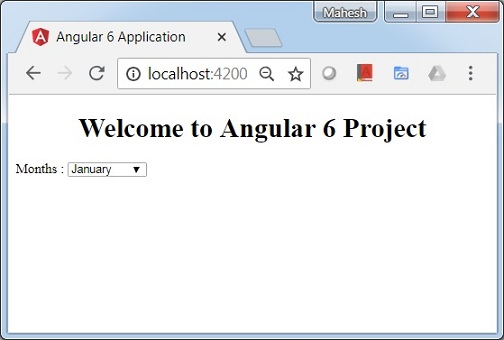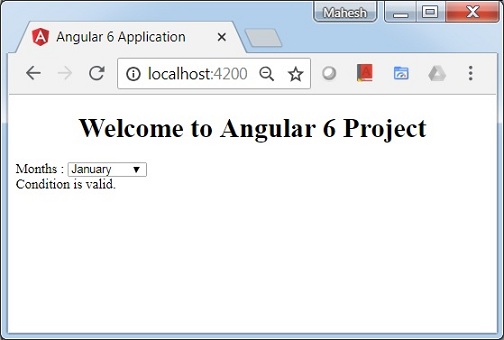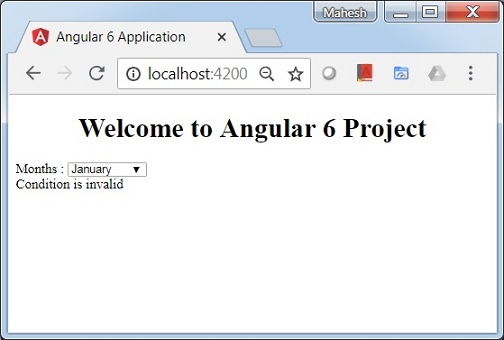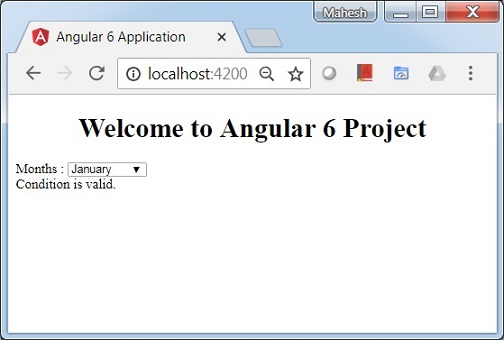- Angular 6-数据绑定(1)
- Angular 4-数据绑定
- Angular 7数据绑定
- Angular 4-数据绑定(1)
- Angular 7属性绑定
- Angular 4-事件绑定
- Angular 7事件绑定
- Angular 8中的事件绑定(1)
- Angular 8中的事件绑定
- Angular 7事件绑定(1)
- Angular 6-事件绑定
- Angular 4-事件绑定(1)
- Angular 2-元数据
- Angular 2-元数据(1)
- Angular 8中的样式绑定(1)
- Angular 8中的样式绑定
- Android中的数据绑定示例
- Android中的数据绑定示例(1)
- r r 将数据帧列表绑定到一个数据帧中 (1)
- 绑定值 (1)
- F#让绑定(1)
- F#让绑定
- kotlin 中的数据绑定(1)
- ReactJS 数据绑定
- ReactJS 数据绑定(1)
- kotlin 代码示例中的数据绑定
- 启用数据绑定 (1)
- AngularJS |数据绑定
- AngularJS |数据绑定(1)
📅 最后修改于: 2020-10-28 05:25:07 🧑 作者: Mango
数据绑定可从AngularJS,Angular 2,4开始使用,现在也可以在Angular 6中使用。我们将花括号用于数据绑定-{{}};此过程称为插值。在前面的示例中,我们已经看到了如何声明变量title的值,并在浏览器中打印出相同的值。
app.component.html文件中的变量称为{{title}},并且title的值在app.component.ts文件和app.component.html中初始化,然后显示该值。
现在让我们在浏览器中创建一个下拉列表。为此,我们在app.component.ts中创建了一个月份数组,如下所示:
import { Component } from '@angular/core';
@Component({
selector: 'app-root',
templateUrl: './app.component.html',
styleUrls: ['./app.component.css']
})
export class AppComponent {
title = 'Angular 6 Project!';
// declared array of months.
months = ["January", "Feburary", "March", "April", "May",
"June", "July", "August", "September",
"October", "November", "December"];
}
上面显示的月份数组将显示在浏览器的下拉列表中。为此,我们将使用以下代码行-
Welcome to {{title}}.
Months :
我们使用选项创建了普通的select标签。在选项中,我们使用了for循环。 for循环用于迭代月份的数组,这反过来将创建带有月份中存在的值的选项标签。
Angular中的语法为* ngFor =“ let I of months” ,要获取月的值,我们将其显示在{{i}}中。
两个大括号有助于进行数据绑定。您在app.component.ts文件中声明变量,并且将使用大括号将其替换。
让我们在浏览器中查看上个月数组的输出

可以使用大括号将app.component.ts中设置的变量与app.component.html绑定。例如{{}} 。
现在让我们根据条件在浏览器中显示数据。在这里,我们添加了一个变量并将其值分配为true。使用if语句,我们可以隐藏/显示要显示的内容。
例
import { Component } from '@angular/core';
@Component({
selector: 'app-root',
templateUrl: './app.component.html',
styleUrls: ['./app.component.css']
})
export class AppComponent {
title = 'Angular 4 Project!';
//array of months.
months = ["January", "February", "March", "April",
"May", "June", "July", "August", "September",
"October", "November", "December"];
isavailable = true; //variable is set to true
}
Welcome to {{title}}.
Months :
Condition is valid.
输出

让我们使用IF THEN ELSE条件尝试上面的示例。
例
import { Component } from '@angular/core';
@Component({
selector: 'app-root',
templateUrl: './app.component.html',
styleUrls: ['./app.component.css']
})
export class AppComponent {
title = 'Angular 4 Project!';
//array of months.
months = ["January", "February", "March", "April",
"May", "June", "July", "August", "September",
"October", "November", "December"];
isavailable = false;
}
在这种情况下,我们将isavailable变量设置为false。要打印else条件,我们将必须创建ng-template ,如下所示:
Condition is invalid
完整的代码看起来像这样-
Welcome to {{title}}.
Months :
Condition is valid.
Condition is invalid
如果与else条件一起使用,并且使用的变量为condition1 。为ng-template分配了相同的ID ,并将可用变量设置为false时,将显示条件无效的文本。
以下屏幕截图显示了浏览器中的显示。

现在让我们使用if then else条件。
import { Component } from '@angular/core';
@Component({
selector: 'app-root',
templateUrl: './app.component.html',
styleUrls: ['./app.component.css']
})
export class AppComponent {
title = 'Angular 4 Project!';
//array of months.
months = ["January", "February", "March", "April",
"May", "June", "July", "August", "September",
"October", "November", "December"];
isavailable = true;
}
现在,我们将尽变量isavailable为真。在html中,条件通过以下方式编写-
Welcome to {{title}}.
Months :
Condition is valid.
Condition is valid
Condition is invalid
如果变量为true,则为condition1 ,否则为condition2 。现在,创建了两个模板,其ID为#condition1和#condition2 。
浏览器中的显示如下-
